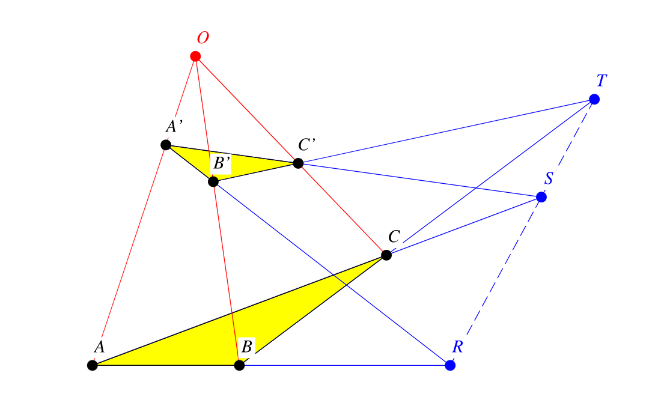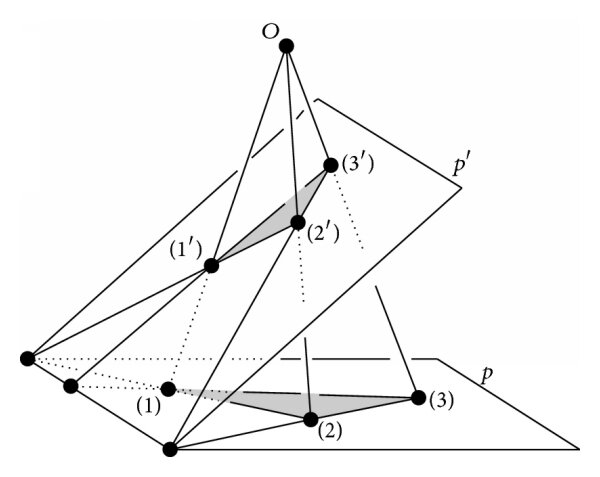Reflections on Reflections

What happens when you compose two reflections?
Using the applet below, move the point P to see what happens when it is reflected over line n (to point P') and then over line m (to point P''). Alter line n by moving point Q. What is the combined effect of the two reflections?
What if the two lines of reflection are parallel?
Use the applet below to investigate the result of composing two reflections across lines that are parallel. What might you conjecture for this case?
What do you think of this proof?
Let A be an arbitrary point in the plane and consider its reflection over line m, followed by a reflection over line n. By definition of (mirror) reflection, the first reflection will transform A to a point, A', that lies on the perpendicular to m passing through A; and the distance, d[sub]1[/sub], to m (along that perpendicular line) will be the same for both points. [br][br]Because lines n and m are parallel, the reflection of point A' across n will transform A' along that same perpendicular line to point A'', where A' and A'' have the same distance, d[sub]2[/sub], to line n. [br][br]Note that d[sub]1[/sub]+d[sub]2[/sub] is the distance between lines m and n. So every point in the plane is translated in the same direction (perpendicular to lines m and n) by the same amount (twice the distance between the lines).
Composing two rotations
Composing two reflections yields a rotation or a translation. So, what happens when you compose two rotations? The app below shows the results of rotating the Hokie Bird through angle A and then angle B. It also shows what happens to the Hokie Bird when reflected over the two lines that make up each rotation. Try moving the original Hokie bird (the one with blue dots) and see the effects of each reflection and rotation, as well as their compositions.
Composing a Rotation and a Translation
The applet below represents a rotation of the plane, about point B, by angle ABC, followed by a translation of the plane, as indicated by the direction and length of DE. Show that their composition can be represented by the composition of two reflections.
Collapsing Reflections
The applet below represents a composition of reflections of the plane, over four lines: a, b, c, and d. Show that we can "collapse" that composition down to a composition of reflections over two lines
Platonic Constructions
Constructing polygons
[size=100]In the applet shown below, you are given an arbitrary line segment, which we will say has a length of 1 unit.[br][br][/size]Using only the following tools construct as many regular polygons as you can. See if you can construct them so that they are inscribed in the unit circle.[br][br]1) Circle with Center: To construct a circle, you choose a center point and a point on the circle.[br]2) Line: To construct a line you choose two points on it.[br]3) Point: You construct a point at the intersection of two lines/circles.
The Fifth Postulate
Desargues's Theorem

What does Desargues's Theorem state?
Let [math]\bigtriangleup ABC[/math] and [math]\bigtriangleup DEF[/math] be triangles lying in the same or different planes. [br]Then, the lines [math]AD[/math], [math]BE[/math], and [math]CF[/math] intersect at a point [math]O[/math] if and only if:[br][br] [math]AB[/math] intersects [math]DE[/math] at a point [math]L[/math][br] [math]BC[/math] intersects [math]EF[/math] at a point [math]M[/math][br] [math]CA[/math] intersects [math]FD[/math] at a point [math]N[/math][br][br]with [math]L,M,N[/math] collinear.[br][br]In other words, two triangles are perspective from a point if and only if they are perspective from a line (concurrency and collinearity).

Proof for Desargues's Theorem
[b][br][br][br]Concurrency -> Collinearity (Non-Coplanar)[br][/b][br]Let [math]\bigtriangleup ABC[/math] and [math]\bigtriangleup DEF[/math] be two triangles that do not lie in the same plane. Assume the lines [math]AD,BE,CF[/math] all meet at a single point [math]O[/math].[br][br]Consider that each triangle defines a plane, can these planes [math]p1[/math] and [math]p2[/math] respectively. Since the two planes are not identical by assumption, they must intersect at a line. Call it [math]L[/math]. [br][br]Now, since the lines [math]AD,BE[/math] both pass through [math]O[/math], all these points exist in the same plane. In other words, we can say [math]A,D,B,E,O[/math] all lie in the same plane. Since this plane cannot be parallel to [math]L[/math], it will intersect [math]L[/math] at a unique point. This unique point will be the intersection of lines [math]AB[/math] and [math]DE[/math].[br][br]Repeat this logic for the planes containing [math]BE,CF[/math] and [math]CF,AD[/math]. We find that the intersections: [br][math]AB\cap DE[/math], [math]BC\cap EF[/math], and [math]CA\cap FD[/math] all lie along line [math]L[/math]. [br][br]Thus, concurrency implies collinearity for the non-coplanar case.[br][br][br][br][b]Concurrency -> Collinearity (Coplanar)[br][br][/b]Let [math]\bigtriangleup ABC[/math] and [math]\bigtriangleup DEF[/math] be two triangles that lie in the same plane. Assume the lines [math]AD,BE,CF[/math] all meet at a single point [math]O[/math].[br][br]We can use a method called lifting to perform a very simple proof. Choose a point [math]E[/math] that does not lie in the plane of the two triangles. Then, "lift" one of the vertices out of the plane by choosing a point, say [math]A[/math], and choosing a new point [math]A'[/math] along the line [math]AE[/math]. Similarly choose a new point [math]D'[/math] along the line [math]DE[/math]. [br][br]Now, we have two new triangles, [math]\bigtriangleup A'BC[/math] and [math]\bigtriangleup D'EF[/math] which are non-coplanar. Apply the above non-coplanar proof to these two new triangles, resulting in our line [math]L[/math]. Finally, project the configuration from point [math]E[/math] back onto the original plane. [br][br]Since projection preserves collinearity, we have that concurrency implies collinearity for the coplanar case as well.[br][br][br][br][b]Collinearity -> Concurrency (Coplanar/Non-Coplanar)[br][br][/b]The other direction is fairly straightforward. Assume [math]AB\cap DE[/math], [math]BC\cap EF[/math], and [math]CA\cap FD[/math] all lie along line [math]L[/math] with [math]\bigtriangleup ABC[/math] and [math]\bigtriangleup DEF[/math] non-coplanar. Then we must have that each of these pairs share a plane (the plane containing [math]A,B,D,E[/math], for example). These three planes will then intersect at a point, call it [math]O[/math]. (We're essentially creating a triangular pyramid using three planes, with point [math]O[/math] as the tip). [br][br]For the coplanar case, we can again use lifting in the same way do the for the forward direction, lifting up, applying the non-coplanar proof, then projecting back down.[br][br][br][br][b]Conclusion:[br][br][/b]From the above, concurrency implies collinearity and vice versa. Therefore, two triangles are perspective from a point if and only if they are perspective from a line.
Where Does the Theorem Fail?
In 3-dimensional space, Desargues's Theorem will always work. You can always rearrange the triangles in 3D so that the theorem holds. This assumption is a big part of our "lifting" proof above. [br][br]In 2D, Desargues's Theorem still holds for most planes. These kind of planes are called Desarguesian. However, Non-Desarguesian planes have been discovered in which the theorem fails. Examples include:[br][br]- The Moulton plane, which is identical to [math]\mathbb{R}^2[/math] aside from the fact that lines with a negative slope have their slope doubled when they pass the y-axis. [br][br]- Hall plane and Hughes plane: projective planes of order 9 which cannot be described using ordinary field arithmetic. [br][br][br]
Why Does it Matter?
In normal Desarguesian planes, the fact that Desargues's theorem holds is very deeply connected to being able to assign coordinates to all points and lines in a way that follows usual algebra. Because of this, Non-Desarguesian planes give us insight into alternative geometric systems and are therefore a huge subject of study in finite geometry, which has applications in coding theory, cryptography, network design, and quantum information theory.
